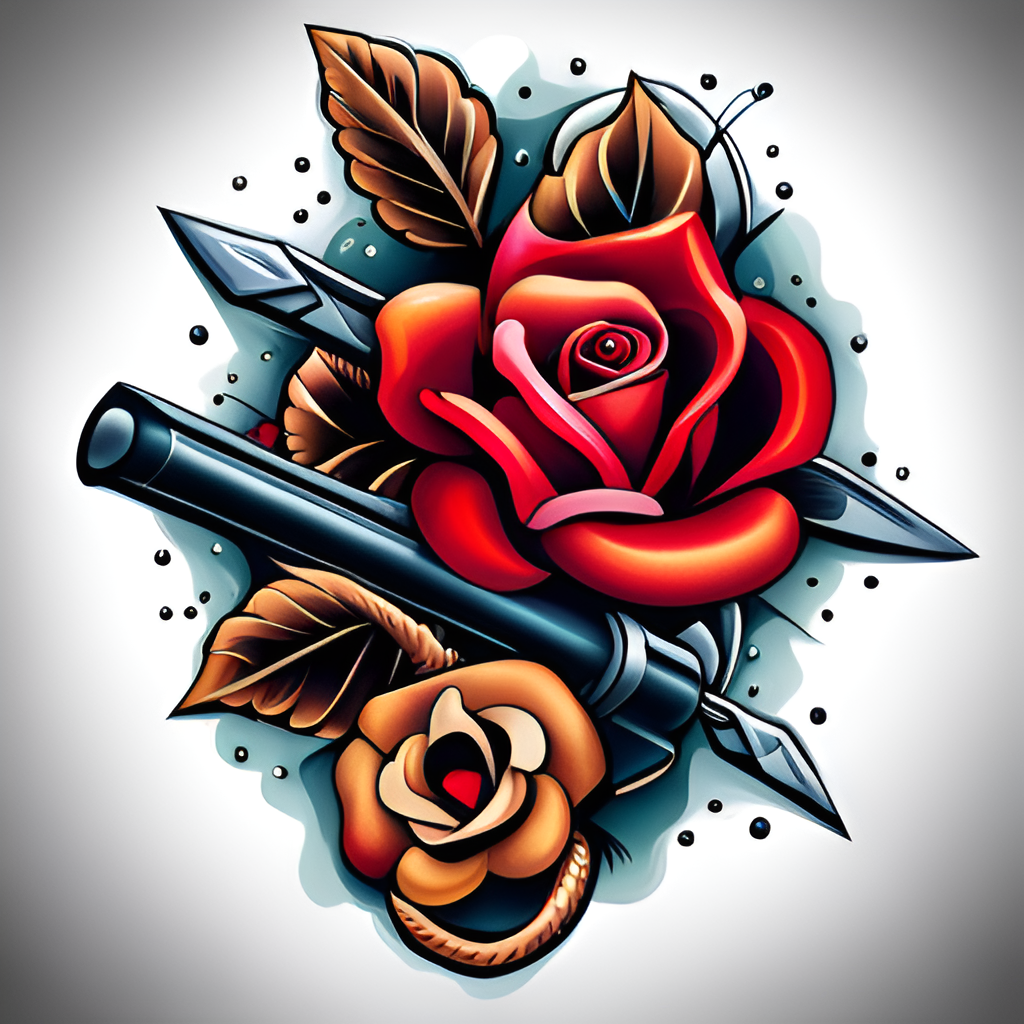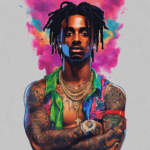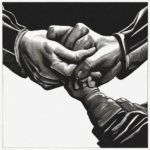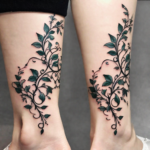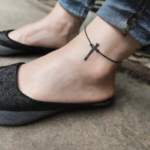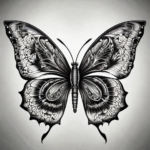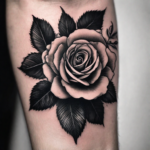Hood gangster drawings have a rich history and cultural significance. Gang members and criminals have popularized these tattoos over the years, but have deep roots in traditional tattooing practices. In this blog post, we will explore the origins and evolution of gangster hood forearm tattoos, their symbolism and meanings, and their place in modern Society.
Table of Contents
Symbolism Behind Popular Hood gangster drawings
Rose Tattoos
A rose tattoo is a symbol of love, passion, and devotion. It can also represent beauty, strength, and resilience in adversity. In gang culture, a rose tattoo may also signify a willingness to defend oneself or one’s loved ones at all costs.
Clock Tattoos
A clock tattoo can represent the passage of time, the inevitability of death, or the importance of making the most of every moment. In gang culture, a clock tattoo may also symbolize a prison or life sentence, with the hands of the clock representing the time that must be served.
Skull Tattoos
A skull tattoo can represent mortality, danger, and rebellion. It can also symbolize a willingness to face death or danger without fear. In gang culture, a skull tattoo may also signify a desire to kill or a reminder of loved ones who have died.
Tattoo Designs for Men and Women
Hood gangster drawings are famous for men and women looking to express their individuality and connection to gang culture. These tattoos often feature powerful symbols and designs representing strength, loyalty, and toughness.
Popular Gangster Hood Forearm Tattoo Designs
Some of the most famous gangster hood forearm tattoo designs include:
- Skulls and skeletons
- Gang symbols and logos
- Guns and Weapons
- Roses and other flowers
- Lions, tigers, and other animals
Different Styles of Hood gangster drawings
Realistic Portraits
- Realistic portraits of famous gangsters like Al Capone or John Dillinger are a popular choice for those looking to pay homage to the history of gangster hood tattoos.
Old School Designs
- Old school designs like roses with guns or banners with bold lettering are also famous for hood gangster drawings.
Script and Lettering
- Script and lettering tattoos are also famous for hood gangster drawings, often featuring phrases or quotes associated with gang culture.
The Evolution of Gangster Hood Tattoos in Modern Culture
Gangster hood tattoos have a long and complex history that can be traced back to the early 20th century. These tattoos were initially used for gang members to identify each other and to show their allegiance to a particular gang or criminal organization. Over time, these tattoos became more elaborate and incorporated specific symbols and designs that held deep meaning for gang members.
Today, gangster hood tattoos have become a part of mainstream culture and are often seen as a symbol of rebellion and non-conformity. While these tattoos still hold meaning for many gang members, they have also become popular among people not involved in criminal activity. Many tattoo artists specialize in gangster hood tattoos and have developed their own unique styles and designs.
Despite increasing popularity, gangster hood tattoos are controversial and often associated with criminal activity and violence. Some people view these tattoos as glorifying gang culture, while others see them as a form of self-expression and individuality. Regardless of your opinion on gangster hood tattoos, it is essential to understand their history and significance in modern culture.
Tattoo Care and Maintenance
Getting a gangster hood forearm tattoo is a big decision, and properly caring for it is crucial to ensure that it looks its best for years to come. Here are some tips on how to manage and maintain your gangster hood forearm tattoo:
Aftercare
Immediately after getting your tattoo, your artist cleans and bandages the area. It’s essential to leave the bandage on for at least a few hours to allow the tattoo to heal correctly. After removing the application, gently wash the tattoo with warm water and mild soap, then pat dry with a clean towel. Apply a thin layer of ointment or lotion to keep the tattoo moisturized.
Daily Care
In the days and weeks following your tattoo, keeping the area clean and moisturized is essential. Avoid exposing the tattoo to direct sunlight and soaking it in water (such as in a bath or swimming pool) until it has fully healed. If your tattoo feels itchy or uncomfortable, resist the urge to scratch it, which can damage the ink and cause scarring.
Long-Term Maintenance
To keep your gangster hood forearm tattoo looking its best for years, taking good care of your skin is essential. This means staying hydrated, eating a healthy diet, and avoiding smoking and excessive drinking. If you spend much time in the sun, apply sunscreen to the tattooed area to prevent fading. And if you’re ever unhappy with the appearance of your tattoo, feel free to consult with your artist about touch-ups or cover-ups.
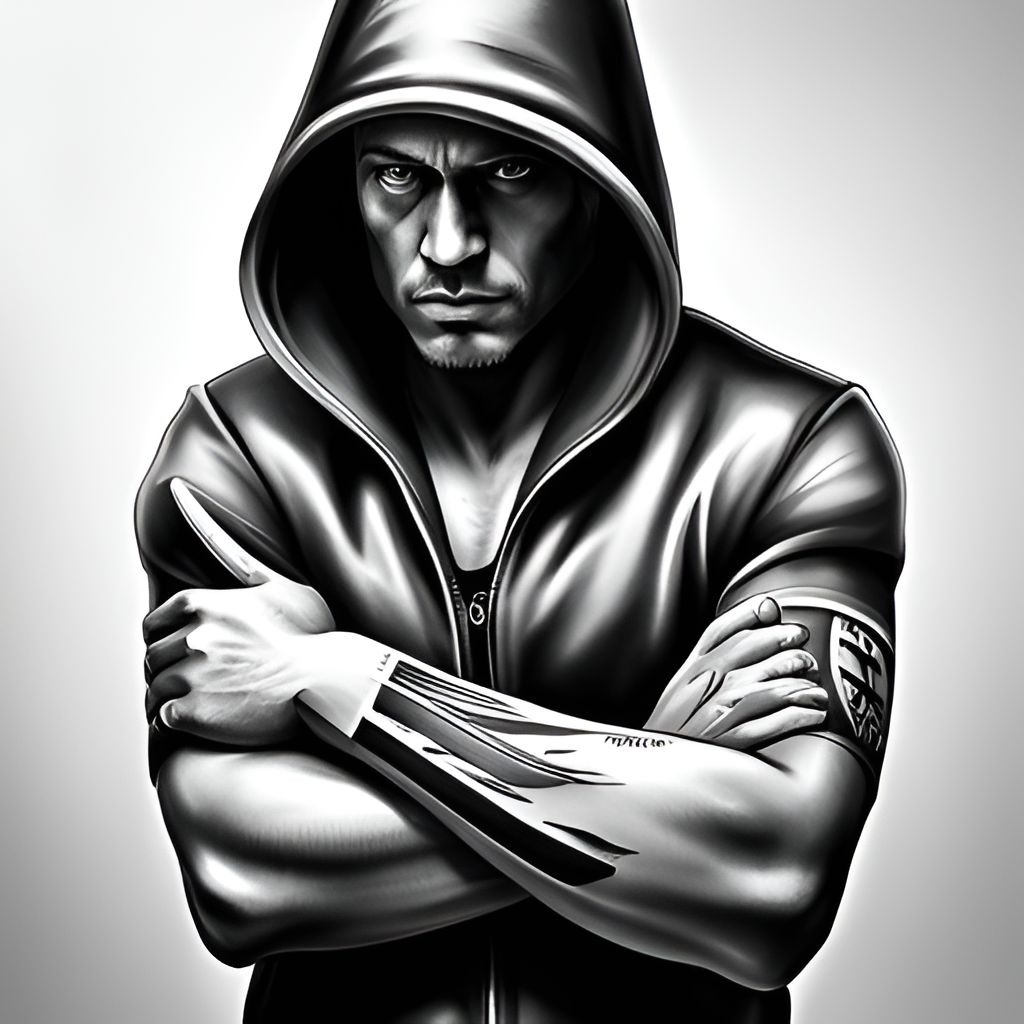
The Risks and Dangers of Getting a Gangster Hood Forearm Tattoo
Infection and Disease
Getting a tattoo always carries the risk of infection and disease, but hood gangster drawings are particularly risky. These tattoos are often done in unsanitary environments and with unsterilized equipment, increasing the risk of contracting blood-borne diseases like HIV and hepatitis.
Scarring and Keloids
Hood gangster drawings are often done with heavy, dark ink and require a lot of shading, which can lead to scarring and keloids. These types of tattoos are also more prone to fading and distortion over time, making them look unappealing or unrecognizable.
Legal and Social Consequences
Hood gangster drawings are often associated with criminal activity and can carry legal and social consequences. A visible gang-related tattoo can make it challenging to find employment or housing and even put you at risk for violence or harassment.
Famous Hood gangster drawings and Their Meanings
Tears
The teardrop tattoo is one of the most recognizable gangster hood tattoos. It is often associated with murder and represents the loss of a loved one or a life sentence in prison.
Praying Hands
The praying hands tattoo symbolizes faith and is often seen on gang members who have turned their lives around. It represents a desire for redemption and a commitment to a higher power.
Cross
The cross tattoo is a popular gangster hood tattoo that connects religion and spirituality. It can also represent a personal struggle or sacrifice.
How to Choose the Right Tattoo Artist for Your Gangster Hood Forearm Tattoo
Research Potential Artists
Before choosing a tattoo artist for your gangster hood forearm tattoo, it is crucial to research potential artists and their portfolios. Look for artists who specialize in gangster hood tattoos or who have experience with similar styles and designs.
Check for Licensing and Certification
Ensure that the tattoo artist you choose is licensed and certified by the appropriate governing bodies in your area. This will ensure they are adequately trained and adhere to safety and hygiene standards.
Read Reviews and Ask for Referrals
Read reviews from previous clients and ask for referrals from friends or family members who have experience with gangster hood tattoos. This can give you a better idea of the artist’s skill level and customer service.
Hood gangster drawings and Their Place in Society
Hood gangster drawings have a long and complex history, deeply rooted in the subcultures and communities of urban America. These tattoos often signify gang or criminal organization membership and are associated with various negative stereotypes and stigmas. However, these tattoos’ cultural significance and artistic value cannot be ignored, and they continue to hold an essential place in Society today.
Despite their association with criminal activity, hood gangster drawings have become increasingly popular recently, particularly among young people. Many individuals choose to get these tattoos as a way of expressing their identity and connection to a particular culture or community. Others see them as a way of reclaiming the negative stereotypes associated with gangster hood tattoos and using them as a symbol of empowerment and resistance.
While there is no denying the Controversy surrounding hood gangster drawings, it is essential to recognize their place in Society and their role in shaping our cultural landscape. Whether viewed as a form of art, self-expression, or social commentary, these tattoos are a powerful symbol of the complex and multifaceted nature of our Society.
hood gangster drawings and Their Connection to Criminal Activity
The Connection to Criminal Activity
Hood gangster drawings have long been associated with criminal activity, mainly organized crime. These tattoos often serve as a way for gang members to identify themselves and show loyalty to their group. Specific tattoos may sometimes indicate a person’s rank or position within the gang.
While not all individuals with hood gangster drawings are involved in criminal activity, the association is strong enough that many people view these tattoos with suspicion or fear. This can lead to discrimination and prejudice against individuals with these tattoos, even if they are not involved in any illegal activity.
The Cultural Significance of hood gangster drawings
Hood gangster drawings have a long and complex history, deeply rooted in the cultural traditions of various communities. From prison tattoos to gang insignias, these tattoos have been used to convey power, loyalty, and identity messages.
In many communities, gangster hood tattoos are seen as a rite of passage, marking the transition from adolescence to adulthood. They are often used to signify membership in a particular gang or neighborhood and can also be used to display a person’s rank within the gang hierarchy.
The Evolution of Gangster Hood Tattoos in Modern Culture
While gangster hood tattoos have a rich cultural history, they have evolved to reflect changing social norms and cultural values. In recent years, gangster hood tattoos have become more mainstream, with many getting inked to express their individuality and personal style.
The Role of hood gangster drawings in Self-Expression
For many people, gangster hood tattoos are a way to express themselves and their identity. They can be used to convey messages of strength, resilience, and perseverance and can also be used to pay homage to loved ones who have passed away.
The Controversy Surrounding hood gangster drawings
Despite their cultural significance, gangster hood tattoos are not without Controversy. Some view them as symbols of violence, criminal activity, and anti-social behavior. Others argue that they perpetuate negative stereotypes about specific communities and contribute to the marginalization of vulnerable groups.
The Importance of Researching hood gangster drawings Before Getting Inked
If you are considering getting a gangster hood forearm tattoo, it is essential to research and understand the cultural significance and potential risks associated with these tattoos. Make sure to choose a reputable tattoo artist with experience working with gangster hood designs, and be prepared to discuss the meaning behind your tattoo with others.
The Future of hood gangster drawings in the Tattoo Industry
Hood gangster drawings have a long and complex history, and they continue to be a popular tattoo choice for many people today. As the tattoo industry continues to evolve and grow, gangster hood forearm tattoos will likely remain a significant part of the culture. However, some potential changes could impact the Future of these tattoos.
Greater Acceptance and Mainstream Popularity
One potential Future for hood gangster drawings is that they become even more accepted and mainstream. As tattoos become more common and less stigmatized in Society, gangster hood tattoos may also become more widely accepted. This could lead to more people getting these tattoos and more tattoo artists specializing in this style.
Innovation and Evolution of Designs
Another potential future for hood gangster drawings is that they continue to evolve and change over time. As new tattoo styles and techniques emerge, it is possible that new designs and variations of gangster hood tattoos will also occur. This could lead to even more creative and unique tattoos incorporating the traditional elements of gangster hood tattoos with new and innovative twists.
Continued Controversy and Criticism
Despite the potential for greater acceptance and innovation, it is also possible that hood gangster drawings will continue to face criticism and Controversy. Some people may view these tattoos as inappropriate or offensive, and ongoing debates about their cultural significance and appropriateness may exist. This could lead to some people needing more time to get these tattoos or to tattoo artists needing to be more selective about the types of tattoos they are willing to do.

The Impact of hood gangster drawings on Pop Culture
Hood gangster drawings have significantly impacted pop culture, particularly in the realm of fashion and style. These tattoos have become increasingly popular recently, with many celebrities and influencers sporting them on their arms.
One reason for the popularity of hood gangster drawings in pop culture is their association with toughness and rebellion. These tattoos are often seen as a symbol of strength and resilience and can be a way for individuals to express their identity and personal values.
Another reason for the popularity of hood gangster drawings in pop culture is their versatility. These tattoos can be designed in various styles, from traditional to realistic to abstract, and can incorporate a range of symbols and imagery.
Hood gangster drawings have also been featured in popular media, such as movies, TV shows, and music videos. This exposure has helped to popularize these tattoos further and make them more mainstream.
The Future of hood gangster drawings in Pop Culture
As with any trend in pop culture, it is difficult to predict the Future of hood gangster drawings. However, these tattoos will likely continue to be popular among certain groups, particularly those who value toughness, rebellion, and self-expression.
The Impact of hood gangster drawings on Society
While hood gangster drawings may be famous in pop culture, they are not without Controversy. Some view these tattoos as promoting a negative image of toughness and violence and may associate them with criminal activity.
However, others argue that these tattoos can be a form of self-expression and a way for individuals to reclaim their identity and personal values. Ultimately, the Impact of gangster hood forearm tattoos on Society is complex and multifaceted.
The Role of hood gangster drawings in Self-Expression
Hood gangster drawings have long been a symbol of rebellion and self-expression. For many individuals, these tattoos represent a way to express their identity and individuality in a way that is both permanent and highly visible. The symbolism behind gangster hood forearm tattoos can vary widely, including cultural or religious references to personal beliefs or experiences.
In recent years, hood gangster drawings have become increasingly popular among men and women. This is partly due to the growing acceptance of tattoos in mainstream Society and the increasing popularity of gangster hood culture and fashion. Many people choose to get gangster hood forearm tattoos to show their connection to this culture or express their admiration for the artistry and skill required to create these intricate designs.
Ultimately, the role of hood gangster drawings in self-expression is profoundly personal. For some individuals, these tattoos represent a way to assert their identity and individuality in a world that often seeks to suppress these qualities. For others, they may be a way to express their love of art and fashion. Whatever the reason, gangster hood forearm tattoos are a powerful symbol of self-expression and individuality that will likely continue to be famous for years.
hood gangster drawings and Their Connection to Masculinity
The Connection Between Gangster Hood Tattoos and Masculinity
Hood gangster drawings have long been associated with masculinity and toughness. In many cultures, tattoos are seen as a rite of passage for young men, a way to prove their strength and resilience. The gangster hood tattoo takes this idea to the extreme, with designs that often feature violent or aggressive imagery. For many men, getting a gangster hood tattoo can assert dominance and show their allegiance to a particular gang or group.
However, it’s important to note that not all men who get gangster hood tattoos do so for these reasons. For some, it is a way to express their individuality or to pay homage to their cultural heritage. Regardless of the motivation behind the tattoo, it’s clear that gangster hood tattoos have become a symbol of masculinity and toughness in many parts of the world.
The Psychological Significance of Gangster Hood Forearm Tattoos
Hood gangster drawings are often associated with a sense of toughness, rebellion, and power. For many individuals, getting a gangster hood forearm tattoo can be a way to assert their identity and establish a sense of belonging within a particular subculture or group.
However, the psychological significance of hood gangster drawings can vary depending on the individual and their experiences. For some, getting a gangster hood forearm tattoo may be a way to cope with past trauma or difficult life circumstances. The tattoo can remind them of their strength and resilience in the face of adversity.
Additionally, gangster hood forearm tattoos can be a way for individuals to express their emotions and feelings visually. The tattoo can represent a particular emotion or experience the individual wants to commemorate or remember.
Overall,hood gangster drawings can hold a deep personal significance for individuals, serving as a form of self-expression and a way to assert their identity and place in the world.
The Artistry and Skill Required for Gangster Hood Forearm Tattoos
Gangster hood forearm tattoos require much skill and artistry to execute correctly. These tattoos often feature intricate designs and shading and require a steady hand and attention to detail to ensure that the final product is aesthetically pleasing and technically sound.
Tattoo artists who specialize in hood gangster drawings must be able to work with a variety of different skin tones and textures and must be familiar with the specific design elements and symbolism associated with these tattoos. They must also be able to work quickly and efficiently, as gangster hood tattoos are often quite large and require multiple sessions to complete.
In addition to technical skills, tattoo artists who specialize in gangster hood forearm tattoos must also possess a deep understanding of the cultural and historical significance of these tattoos. They must be able to work closely with clients to understand their personal stories and motivations for getting inked. They must be able to translate those stories into meaningful and impactful designs.
The Role of Gangster Hood Forearm Tattoos in Gang Culture
Hood gangster drawings have been an integral part of gang culture for decades. These tattoos serve as a form of identification and representation of loyalty to a gang or gang affiliation. They are often used to intimidate rival gangs and to show solidarity with fellow gang members.
Gangster hood forearm tattoos can also indicate a rank within a gang. For example, a member with a teardrop tattoo under their eye may signify that they have killed someone for the club. Similarly, a spider web tattoo on the elbow indicates the member has spent time in prison.
In some cases, hood gangster drawings can also serve as protection. Gang members with tattoos may be less likely to be targeted by rival gangs or law enforcement due to their perceived association with a dangerous and violent group.
The Importance of Researching Gangster Hood Forearm Tattoos Before Getting Inked
Gangster hood forearm tattoos have a rich history and cultural significance. They are often associated with criminal activity and gang culture but have deep meanings and symbolism. If you are considering getting a gangster hood forearm tattoo, it is essential to do your research and understand the implications of this type of tattoo.
Researching hood gangster drawings involves understanding their history, symbolism, and cultural significance. Knowing what the tattoo represents and how others perceive it is essential. It would help if you also researched different tattoo designs and styles to find one that resonates with you and your style.
Another important aspect of researching hood gangster drawings is finding the right tattoo artist. Look for an experienced and reputable artist specializing in this type of tattoo. Check their portfolio to see examples of their work and read reviews from previous clients. It is also important to discuss your design ideas and any concerns you may have with your artist before getting inked.
Before getting a gangster hood forearm tattoo, it is also essential to consider the risks and dangers involved. Tattoos can be painful and may cause health complications if not done correctly. Following proper aftercare instructions and keeping the tattoo clean and moisturized is necessary to prevent infection.
Conclusion: The Significance and Impact of Gangster Hood Forearm Tattoos
Gangster hood forearm tattoos have a rich history and cultural significance, often representing a person’s affiliation with a particular gang or their struggles and triumphs. While these tattoos have been associated with criminal activity and negative stereotypes, they also serve as a form of self-expression and artistic skill.
It is essential to research and understand the meaning and symbolism behind gangster hood forearm tattoos before getting inked and choose a reputable tattoo artist who can bring your vision to life while prioritizing your safety and health.
As the tattoo industry continues to evolve, hood gangster drawings will likely remain in both popular culture and personal expression. Whether you embrace or reject the controversial nature of these tattoos, it is clear that they significantly impact Society and the individuals who wear them.
